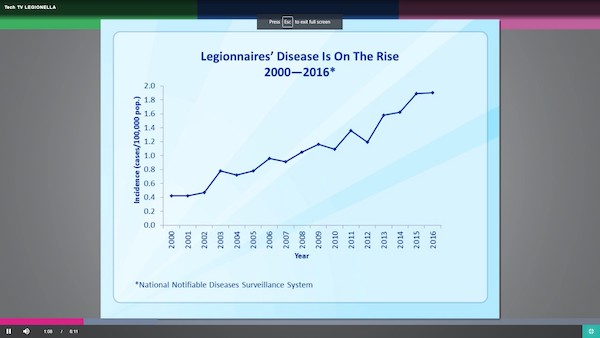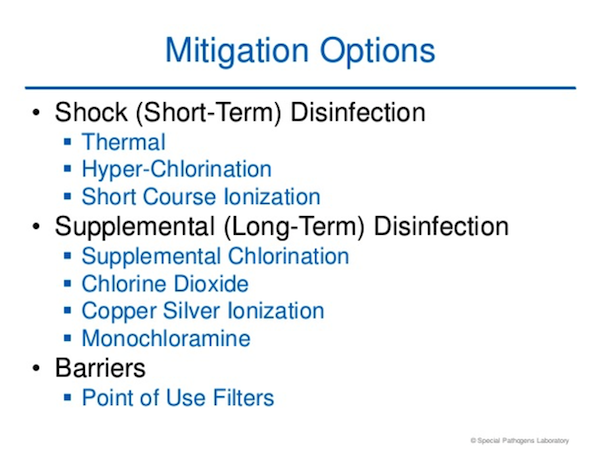Sixth video in the Tech TV series presents pros and cons of various control strategies. Lindon, UT — Preventing Legionnaires’ disease by controlling the growth of Legionella bacteria in water systems is the topic of the latest Tech TV video from Aquatherm. The video is available at https://aquatherm.com/videos/legionella. Legionnaires’ disease is transmitted through inhalation of Read more
Legionnaire’s Disease
Sixth video in the Tech TV series presents pros and cons of various control strategies.
Lindon, UT — Preventing Legionnaires’ disease by controlling the growth of Legionella bacteria in water systems is the topic of the latest Tech TV video from Aquatherm. The video is available at https://aquatherm.com/videos/legionella.
Legionnaires’ disease is transmitted through inhalation of water vapor in which the Legionella bacterium is present. It can present a very serious health risk to susceptible populations. Sources in a building can include misters, humidifiers, whirlpools and spas, evaporative coolers, and open- and closed-loop cooling towers. The best means of controlling Legionnaires’ Disease is by eradicating Legionella from a building’s water supply.

In this Tech TV video, Jim Paschal, P.E., Chief Technology Officer, Aquatherm North America, evaluates the pros and cons of various chemical and non-chemical Legionella control strategies, including hyper chlorination, chlorine dioxide, monochloramine, copper-silver ion generation, heat, and ultraviolet light.
The Legionella video is the sixth in the series of Aquatherm Tech TV videos. Other topics have been mixed systems, temperature, pressure, flow rate, and support considerations. All Tech TV videos can be found here: https://aquatherm.com/video-library. All of the videos in the series are free and available 24/7.

The oyster appetizer tray made its way around the table during our group dinner, and I asked the guy sitting next to me if he wanted first dibs, to which he replied, “No thanks, I know where they’ve been.” I mean, I kinda knew, but maybe not as much as this guy? So I declined Read more
The oyster appetizer tray made its way around the table during our group dinner, and I asked the guy sitting next to me if he wanted first dibs, to which he replied, “No thanks, I know where they’ve been.” I mean, I kinda knew, but maybe not as much as this guy? So I declined, as well.
Turns out, “that guy” sitting next to me was Frank Sidari, PE, BCEE, Technical Director, Special Pathogens Laboratory (SPL), and one of the featured speakers at a recent Watts Water Technologies Healthcare Symposium. Sidari was there to speak about Legionella and its growth, and the growing concern in the industry.

“No one should die from a preventable disease caused by bacteria in water,” said Sidari, suggesting that Legionnaires’ Disease is on the rise. Part of this rise correlates to the fact that there wasn’t really any testing being done for Legionella. Yet, it’s one of those “It’s never going to happen to me”-type diseases. What could have been mistaken for other ailments, the disease was often times diagnosed as pneumonia or the flu in older people, or those with auto-immune disorders.
According to the SPL presentation, public water supplies may contaminate the plumbing systems of hospitals and other large buildings. In fact, Legionella bacteria is not ubiquitous, but are found in 50% of building water systems—not all—which consist of:
- 12-70% of hospital water systems
- Up to 60% of large high-rise buildings
- 10-40% of residential homes
- 30-50% of cooling towers colonized with Legionella
Legionella can be found in building warm water systems such as faucets, showers, hot water tanks, decorative fountains, pools, spas and cooling towers, for example.
Transmission of pathogenic Legionella in the water system is the aerosolization and aspiration from an environmental source into the lungs—when the exposure to contaminated water reaches the airways—and because it is chlorine tolerant, it can survive the water treatment process and pass into the water distribution system. It grows in the water systems in the right conditions, i.e. water temperature, sediment and commensal microbes. Again, the disease can occur if the host is susceptible.

Frank Sidari
Variables such as water flow, distribution, velocity and temperature and play an important part for risk reduction. Risk factors such as water supply, building use and size, system design and hot water set-up all contribute to a safe and effective plumbing system.
The Center for Disease Control and Prevention has reported that Legionella accounted for 66% of reported drinking water-associated outbreaks, and Legionella in building plumbing systems lead to drinking water-associated outbreaks.
As there has been movement for the Center of Disease Control to develop a water management program to reduce Legionella growth in buildings, Illinois senators, for example, sent a letter to the leaders of three health-related agencies—the Centers for Disease Control and Prevention, the Department of Veterans Affairs, and the EPA—asking for their help in responding to a Legionnaires’ disease outbreak at a state-run veterans home, in Manteno, says Dain Hansen, Senior Vice President, Government Relations, The IAPMO Group.
This comes on the heels of a Legionnaires’ disease outbreak at an Illinois veterans’ home in Quincy that killed 14 people since 2015.Traction is being made in Illinois. “In response to the ongoing crisis, Illinois’ new governor, J.B. Pritzker, has established a Legionnaires’ disease task force, and the senators also requested that the three federal agencies participate in that effort,” says Hansen.
In New York state, environmental assessments are required with a Legionella sampling and risk management plan is in place where <30% distal outlet positivity requires corrective action.
Industry-wide, ASHRAE Standard 188, the first Legionella standard in the U.S., which was approved in 2015 and revised in 2018, establishes minimum Legionellosis risk management requirements for building water systems.
According to the Special Pathogens Laboratory, zero Legionella is virtually impossible to achieve in complex water systems so zero cases is the goal, not zero Legionella through Legionella control. The SPL suggests that in hospitals and long-term care facilities—and other facilities I would presume—establishing water management policies to reduce the risk of growth and spread of Legionella and other opportunistic pathogens, conducting a risk assessment and implementing a water management program are all very good ideas for a facility.
Each building owner must assess the risk and validate their water management plans to demonstrate control of the hazard. The SPL suggests that in hospitals and long-term care facilities—and other facilities, I would presume—establishing water management policies to reduce the risk of growth and spread of Legionella and other opportunistic pathogens, conducting a risk assessment and implementing a water management program are all very reasonable considerations for a facility.

Source: Special Pathogens Lab

Twelve dead and 113 reported cases in an ongoing Legionnaires’ disease outbreak in New York City that dates back to July 10. The culprit? The sneaky SOB incubated in cooling towers in more than a dozen areas. I recall asking, “Why? How?” at a recent “Pathogen Risk Reduction by Design” seminar hosted by Tim Keane Read more
Twelve dead and 113 reported cases in an ongoing Legionnaires’ disease outbreak in New York City that dates back to July 10. The culprit? The sneaky SOB incubated in cooling towers in more than a dozen areas.
 I recall asking, “Why? How?” at a recent “Pathogen Risk Reduction by Design” seminar hosted by Tim Keane in regard to Legionella and plumbing systems design. Tim is a consulting engineer and owner of Legionella Risk Management, Inc. he is also an original voting member of ASHRAE 188 committee serving on that committee for over a decade. How does this happen and why are recent plumbing code changes making this problem more likely rather than less likely to occur?
I recall asking, “Why? How?” at a recent “Pathogen Risk Reduction by Design” seminar hosted by Tim Keane in regard to Legionella and plumbing systems design. Tim is a consulting engineer and owner of Legionella Risk Management, Inc. he is also an original voting member of ASHRAE 188 committee serving on that committee for over a decade. How does this happen and why are recent plumbing code changes making this problem more likely rather than less likely to occur?
Legionella, for example, can cause debilitating, even deadly, results in elderly people and those with compromised immune systems, and cases of Legionnaires’ disease outbreaks are seldom reported and perhaps not seen as a global problem—until recently. “Ninety percent or more of those that get Legionnaires’ disease have risk factors,” says Keane (Risk factors include: age, over 50; smokers, drinkers, diabetes, organ transplants, HIV, and others.)
As a result of the recent New York outbreak, according to the USA Today, New York City Mayor Bill de Blasio said the proposal would require all existing cooling towers to be registered with the city’s Department of Buildings. It also requires regular inspection, testing, cleaning and disinfection. He said the city had created a voluntary online registration database for cooling towers.
“It’s hard to believe that plumbing code changes over the past decade have made plumbing systems more likely to be at risk for Legionella colonization. Of course, what’s happening in NYC, this prolonged outbreak and now the Governor stepping in and telling the NYC mayor that the State and CDC will be getting involved, that’s really hard to believe. A public health crisis and public health officials in the largest city in the U.S. being told things need to change. Maybe we should get the Governor involved in plumbing code changes,” says Keane.
But back to how, and why. The seminar, sponsored by Viega, the company dedicated to water quality solutions through innovative plumbing components, brought to light the importance of plumbing design in overall pathogen risk reduction and control. “Twenty-five percent of Legionnaire’s Disease outbreaks occur within the first year of new construction or renovation,” says Keane.
Legionella can also cause a less-severe influenza-like illness known as Pontiac Fever. Most cases of legionellosis are the result of exposure to Legionella associated with building water systems, according to ASHRAE presidential member Tom Watson, chair of the committee that wrote the 188 Standard (see more below).
Transmission of Legionella is the aerosolization and aspiration from an environmental source into the lungs and because it is chlorine tolerant, it can survive the water treatment process and pass into the water distribution system. It grows in the water systems in the right conditions, i.e. water temperature, sediment and commensal microbes.
According to OSHA guidelines, water operations and proper controls prevent Legionella amplification; it is important to remember that any water system can be a source of disease if the water in it is subjected to conditions that promote growth of the organism. Remember, however, that the primary sources of exposure to contaminated water are heat rejection systems—cooling towers, fluid coolers, etc.—and hot water systems. Maintain domestic water heaters at 140 F and water delivered at the faucet at a minimum of 122 F.
ASHRAE’s guidelines are “conditions that are favorable for the amplification of legionellae growth include water temperatures of 77 F – 108 F, stagnation, scale and sediment, biofilms and the presence of amoebae.”
Variables such as water flow, distribution, velocity and temperature and play an important part for risk reduction. Risk factors such as water supply, building use and size, system design and hot water set-up all contribute to a safe and effective plumbing system. “Potable water is biggest culprit for Legionnaire’s Disease,” said Keane. There are more outbreaks of Legionnaires’ disease associated with potable water however potable water outbreaks tend to have few cases. Cooling tower outbreaks can be many times larger than a potable water outbreak.
Water Supply Risk Factors
• Supply Water Type — Surface water is a much higher risk than well water
• Type of Disinfectant — Chlorine, Monochloramine
• Disinfectant Residual at Building — Distance building from treatment plant; city flushing plan; occupancy rates in area
• Potential for Water Disruption — Renovation, Failure
Building Risk Factors
• Building Use — Expected occupancy rate, Seasonal occupancy fluctuation, phased construction
• Building Size — Increased risk for buildings with more than 10 stories
Plumbing System Design
• Hot and Cold Water Pipe Runs — Insulation, location of runs, distance between hot and cold pipes, volume of stored water, parallel vs. series
“Keep water away from excessive heat sources such as cold water capturing heat from mechanicals or underwater lighting systems that can raise water temps,” says Keane.
• Hot Water Return — Balancing, return pumps, monitoring
• Turnover (Water Aging) — Balancing, flow rate (ft./sec.), volume of water in branches, unused distal sites
Hot Water Heater Setup
• Outlet Temperature
• HW return
• Master Mixing Valve Installation
• Series or Parallel
• Monitoring
ASHRAE Standard 188 is essential for anyone involved in design, construction, installation, commissioning, operation, maintenance, and service of centralized building water systems and components. “ASHRAE 188 will make and immediate impact in the healthcare industry, ” says Keane.
Specific requirements in the standard include:
• Minimum Legionellosis risk management requirements for the design, construction, commissioning, operation, maintenance, repair, replacement and expansion of new and existing buildings and their associated (potable and non-potable) water systems and components.
• Establishment by building owners of a Program Team and (in turn) a Water Management Program for which they are responsible in order to comply with the standard.
• Provision of specific and detailed requirements for what Legionellosis control strategies must accomplish and how they are to be documented – but, does not provide (or place restrictions on) what specific strategies are to be used or applied.
“With 8,000 to 10,000 cases of Legionnaires’ Disease reported each year in the United States, and with more than 10% of those cases fatal, it is vital that we set requirements to manage risk of this bacteria,” said Watson.
